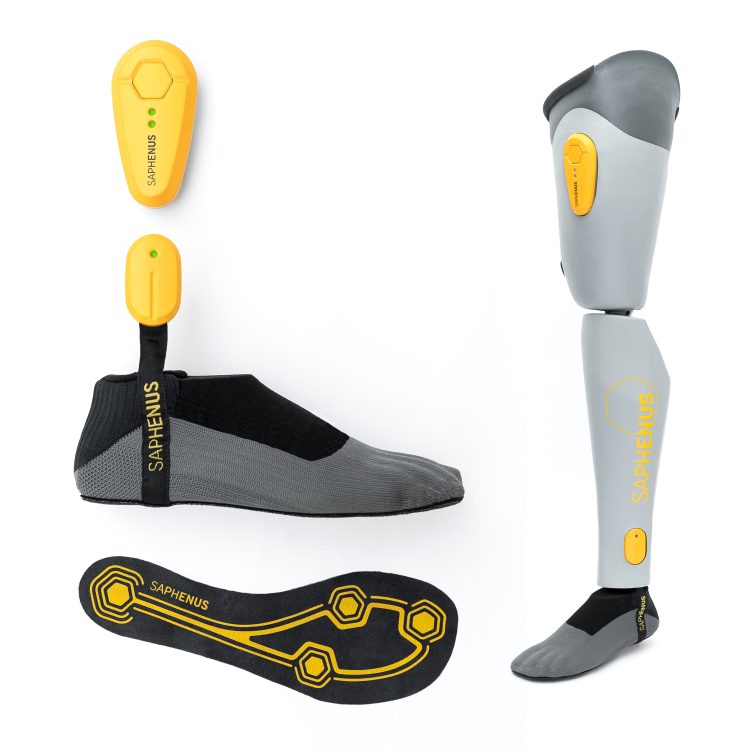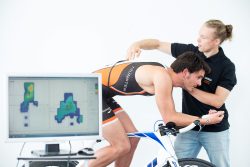When IEE was contacted by Saphenus Medical Technology for a highly specific sensor need, our System Engineers in the Accelerator teams knew immediately they were going to participate in the creation of a product that is, to date, unique in the world.
Download case studySaphenus case study

Client
Saphenus Medical Technology
Location
Krems, Austria
Work
IEE Smart Foot sensor improve life quality for amputees
Saphenus Medical Technology, an Austrian start-up company involved in the development of bionic prosthesis, is the first and only company so far to bring to market a sensory feedback system that helps people with amputations lead a better life, with less pain and increased walking stability.
This innovative system is called “Suralis”, after the sensory nerve in the leg that can be stimulated through reconstructive surgery in the stump, and it is the world’s first add-on that helps give a natural walking feeling. One of the essential components – a sensor liner from IEE that absorbs the rolling motion when placed on the insole of a shoe.
“IEE holds some outstanding technology. At the crossroads of so many disciplines and such complex mechanisms made of parts, the sensors play a major role and will continue to do so.”
Suralis – A Unique Sensory Feedback System that Heals Phantom Pain
The crucial point and the start of Saphenus Medical Technologies was this: To successfully combine experimental surgery with innovative, ground breaking sensors and actuators that result in a pain-relieving, lifesaving sensory feedback system and the development of an adapted bionic prosthesis. Saphenus wanted to deliver a prosthesis that not only had the look and feel of a normal body part for the patients, but which could also alleviate and even take away the phantom pain that affects many amputees.
At the foundation of this start-up: Five people inspired by the work and research of Prof. Dr. Hubbert Egger, the inventor of the mind-controlled arm prosthesis. He discovered that, after the loss of a limb, it is not only the motoric nerves, but also the sensory nerves which are stimulated. His patients were complaining of “feeling” a sensation close to warm water running through an arm or leg which was no longer there. With this idea in mind, he investigated further on how to renovate and stimulate sensory nerves that would in return diminish phantom pain or even make it disappear completely.

His finding has now become a world premiere. For the very first time, phantom pain could be directly targeted and remedied.
“Our main target were patients struggling with life crippling phantom pain and we directed them towards reconstructive, experimental surgery. In practice, the foot nerve in the stump is redirected to the skin area. After roughly two months, this nerve, called nervus suralis, “grows” into the skin, giving the amputee a touch feeling very close to that given by using the actual limb. It is a very, very emotional moment,” says Rainer Schultheis, CEO and Co-founder at Saphenus Medical Technologies.
Some people say that after a while, their bodies cannot distinguish anymore between prosthesis and real foot, so exceptional is the integration.

After the surgery, the Smart Foot sensor comes into play. “Our Smart Foot sensor is fixed on the insole and acts as an interface between the ground and the prosthesis to accurately measure the pressure under the foot during walking. The sensor captures the information that the prosthesis has touched the ground and sends it to an actuator array which activates the surgically redirected nerve endings, located in a specific area of the limb. Thus, the user can “feel” the heel, toes, and the walking feels more natural again,” says Tobias Meyer, System Engineer in the Accelerator Footwear team.
Because the brain registers these feelings, it believes the missing limb is in place and the phantom pain dramatically decreases or completely ceases. On top of alleviating the pain, Suralis also gives improved gait stability and hence, less risk of falling, another reason of concern due to reduced mobility. When the patient receives feedback from the ground, when they “feel” the pavement, they are more stable and enjoy a better balance and overall quality of life.
Partnering with IEE to build an exceptional product
To create a world class product in such a sensitive field one needs strong partnerships. For Saphenus Medical Technologies, having durable and reliable solutions for their sensory feedback system was critical right from the research and development phase.
“For a medical product, it is very important to have a high-quality standard, not least because it has to comply with various regulations,” says Rainer Schultheis. “Our sensory feedback system is a modular mechanism made of several components in the shoe sensor and the sock which detect the rolling movement. They work together to send radar-controlled signals to the upper part of the prosthesis where vibrotactile actuators stimulate non-invasively the renovated area of the stump. There are components below and above the prosthesis.
For the sensor sock, for instance, we had to find solutions that can withstand the test of one million steps. Astonishingly, we have found none available previously, so we run the tests with IEE and found exactly what we needed. A foot prosthesis is typically made of a strong material like titanium, which means it must be solid. We therefore needed sensors that could fit into this complex scenario to create a nonetheless easy-to-use product.”
The collaboration between the two companies kicked-off on the right foot from the beginning, providing excellent ground to start an innovative solution for a sensor sock. Saphenus combined the sensor matrix proposed by IEE with an Italian shoe producer which made samples including the special sensor that supports the sensory feedback system today.
“We used the IEE sensor matrix to make a quick prototype that we could use for a clinical study we did in Austria that was very important to the development of the project. We were happy it was so easy and without complicated conversations to get sensor samples from IEE. The dedicated people in the Accelerators department perfectly understand the needs of start-up companies and we appreciated their involvement a lot. The first contact makes all the difference. IEE allowed us to “try things out” because this is what start-ups need. We wanted to have prototypes for or 3D printing, etc. The help that IEE provided in this matter enabled us to push our research further and meet our strict deadlines. I can say their input was gold. The personal contact was very important to understand the entire process and motivate us to reach our goals,” says Rainer.
Looking into the Future
Saphenus has other great plans in store for the future and it looks like more IEE sensors will make their way into other life-changing or “simply” smart products. Saphenus are hoping to create solutions for people with neurological disorders, for which the feedback system could bring major improvements and hopefully help them avoid amputation. Getting feedback from the ground when one has lost all feeling in the limb could be a massive turning point in the lives of those affected.
Aside from the medical use, the sensory feedback system could fit well into the sports area, as part of a gadget that could help measure or reproduce movements for various purposes.
“IEE holds some outstanding technology,” Rainer appreciates, “and I am sure we will have the chance to work on many more interesting projects in the years to come. In our highly complex field of expertise, the art is to always find new solutions that suit a variety of use cases. We typically juggle with information related to surgery, liaise with medical, design, science, research and technology experts and our sales person is an orthopedics technician in charge of adapting the prosthesis for the person with amputation as necessary. At the crossroads of so many disciplines and such complex mechanisms made of parts, the sensors play a major role and will continue to do so.”
The project has received funding from the European Union Horizon 2020 research and innovation program.
Need a customized solution?
If you want to talk about customization options, price, availability or other related to this product

